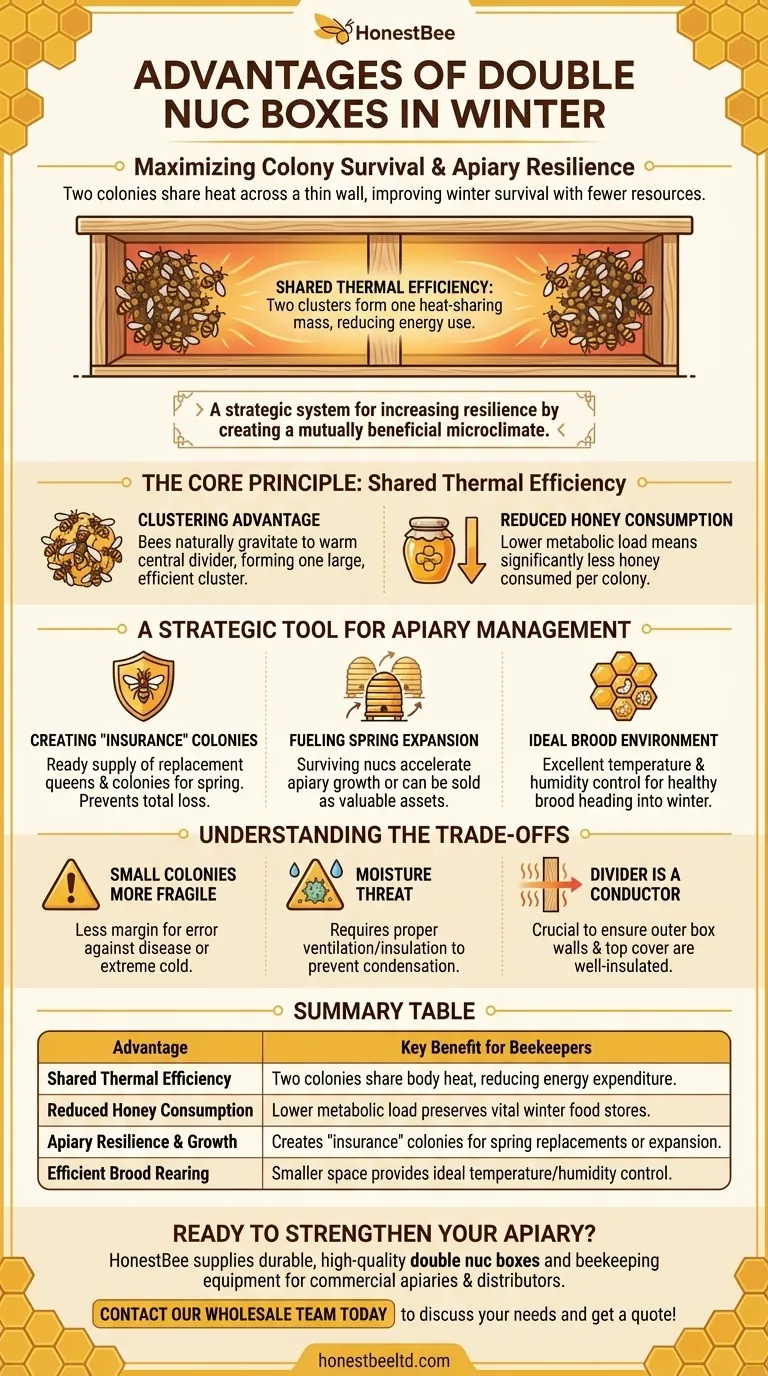The primary advantage of a double nuc box in winter is its ability to house two smaller bee colonies side-by-side, separated by only a thin wall. This arrangement allows the two colonies to share body heat, significantly improving their collective ability to survive cold temperatures while consuming fewer resources than a single large colony.
A double nuc box is more than just a space-saving tool; it's a strategic system for increasing the resilience of your apiary by creating a mutually beneficial microclimate that enhances winter survival rates for smaller, more vulnerable colonies.

The Core Principle: Shared Thermal Efficiency
A double nuc leverages the natural behavior of honey bees to create a more efficient system for overwintering. Understanding this principle is key to using them successfully.
How a Double Nuc Works
The system consists of a single deep box divided lengthwise by a thin wooden wall. Each side has its own entrance, housing a separate, small colony with its own queen.
The Clustering Advantage
In winter, bees form a tight cluster to generate and conserve heat. In a double nuc, the two independent clusters will naturally gravitate toward the warm central divider, effectively forming one larger, heat-sharing mass.
This shared warmth reduces the energy each individual colony must expend to maintain its critical core temperature, especially during prolonged cold spells.
Reduced Honey Consumption
Because the bees work together to generate heat, their metabolic load is lower. This translates directly into lower honey consumption per colony, making it an efficient way to overwinter bees with limited food stores.
A Strategic Tool for Apiary Management
Beyond thermal benefits, double nucs serve a critical role in the beekeeper's long-term strategy for apiary health and growth.
Creating "Insurance" Colonies
Many beekeepers intentionally create several "nucs" (nucleus colonies) during the summer. Overwintering them in double nuc boxes provides a ready supply of replacement colonies.
If a larger production hive dies during the winter, you have a spare queen and colony ready to go in the spring, preventing a total loss.
Fueling Spring Expansion
If all your colonies survive the winter, these extra nucs become a valuable asset. They can be sold to other beekeepers or used to expand your own apiary, accelerating your growth.
An Ideal Brood Environment
The small size of a nuc box provides an excellent environment for raising brood. The bees have better control over internal temperature and humidity, leading to a healthy, strong population heading into winter.
Understanding the Trade-offs
While highly effective, the double nuc system is not without its considerations. Objectivity requires acknowledging potential challenges.
Smaller Colonies are More Fragile
Despite the shared heat, each colony is still small. A very small population has less margin for error if it encounters disease, moisture issues, or an extended period of extreme cold.
Moisture Can Be a Threat
Two clusters of bees produce a significant amount of moisture from respiration. In a confined space, this can lead to condensation and chilled bees if not managed properly with upper ventilation or insulation.
The Divider is a Conductor, Not an Insulator
The thin wall is designed for heat transfer, which is its primary benefit. However, this also means the overall insulation of the outer box walls and top cover is critically important to prevent that shared heat from escaping.
Making the Right Choice for Your Apiary
To decide if this system fits your needs, consider your primary goals.
- If your primary focus is maximizing survival of smaller colonies: A double nuc is an excellent strategy to give late-season splits or weaker hives a significant boost.
- If your primary focus is apiary growth and resilience: Use double nucs to create "insurance" colonies each summer to mitigate winter losses and fuel spring expansion.
- If your primary focus is resource efficiency: Overwintering bees in a double nuc allows you to maintain two queens and colonies with a smaller footprint and lower honey consumption.
Ultimately, the double nuc system is a powerful technique for building a more sustainable and robust beekeeping operation.
Summary Table:
| Advantage | Key Benefit for Beekeepers |
|---|---|
| Shared Thermal Efficiency | Two colonies share body heat, reducing energy expenditure. |
| Reduced Honey Consumption | Lower metabolic load preserves vital winter food stores. |
| Apiary Resilience & Growth | Creates "insurance" colonies for spring replacements or expansion. |
| Efficient Brood Rearing | Smaller space provides ideal temperature/humidity control for healthy brood. |
Ready to strengthen your apiary's winter survival and spring growth?
HONESTBEE supplies durable, high-quality double nuc boxes and other essential beekeeping supplies to commercial apiaries and distributors through our wholesale operations. Our equipment is designed to help you maximize colony resilience and operational efficiency.
Contact our wholesale team today to discuss your needs and get a quote!
Visual Guide

Related Products
- Twin Queen Styrofoam Honey Bee Nucs Mating and Breeding Box
- 5 Frame Wooden Nuc Box for Beekeeping
- Automatic Heat Preservation 6 Frame Pro Nuc Box for Honey Bee Queen Mating
- Portable Bee Mating Hive Boxes Mini Mating Nucs 8 Frames for Queen Rearing
- Plastic Transporting Bee Packages and Nuc Boxes for Beekeeping
People Also Ask
- When can cells safely be given to nuclei? The 12-Day Rule for Successful Queen Introduction
- What are Nucleus Hives and what are they used for? Essential Tools for Apiary Growth & Management
- What are the benefits of using nucs for beginning beekeepers? Ensure a Successful First Hive with a Head Start
- What are the best times to pick up a nucleus colony? Ensure a Strong Start for Your Apiary
- What role do nuc hives play in queen breeding? Master Efficient Queen Rearing for Your Apiary



















